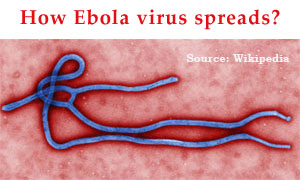
Ebola virus in human spreads through close contact such as physical contact with the infected person or the physical contact with the bodily fluids.
What we know about transmission of the Ebola virus among humans?
This article is based on the Ebola situation assessment by WHO.
The Ebola virus disease is very infectious diseases and it is spread through the close or physical contact with the infected patients. The physical contacts which leads to the spread of Ebola virus are bodily fluids, blood, faces and vomit. The blankets or the clothes used by the infected person may also lead to the spread of virus.
It is also noted that the Ebola virus has also been detected in the breast milk, urine and the semen. In the person recovered from the Ebola virus infection, the virus can persist least 70 days in the semen of the person. One study suggested that it can persist more then 90 days. So, it is also essential to take the adequate precautions even after the recovery from the Ebola infection.
Study also suggest that the saliva and tears may also carry some risk. Study also suggest that the saliva carry the virus at severe stage of illness. There is not evidence of finding the live virus from sweat.
Study shows that the Ebola virus can also spread indirectly, by contact with the contaminated surfaces and the objects. The risk of transmission from these surfaces is very low and it can be minimize further by cleaning and disinfecting the objects.
Not an airborne virus
The Ebola virus disease is not an airborne infection and can't spread through the air.
This mode of transmission has not been observed during extensive studies of the Ebola virus over several decades.
The spread of virus through coughing and sneezing is very rare. The pidemiological data emerging from the outbreak are not consistent with the pattern of spread seen with airborne viruses, like those that cause measles and chickenpox, or the airborne bacterium that causes tuberculosis.
Theoretically, wet and bigger droplets from a heavily infected individual, who has respiratory symptoms caused by other conditions or who vomits violently, could transmit the virus – over a short distance – to another nearby person. This could happen when virus-laden heavy droplets are directly propelled through coughing or sneezing and transmitted to a healthy person.
But according to the WHO study there is no document that supports such transmission method.
No evidence for mutation of this virus
Still there is no evidence of the mutation of Ebola virus. But there is speculation that the Ebola virus might mutate into a form that could easily become airborne.
To stop the Ebola outbreak, well-know protective and preventive measures needs to be implemented on a much large scale.
Source: WHO Report.
|
|
Read More: Ebola


Comments: